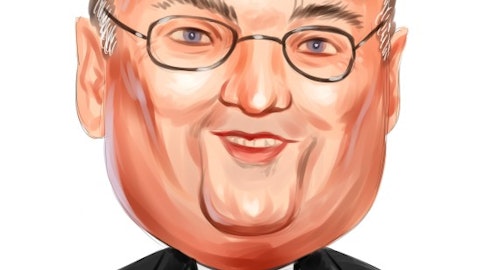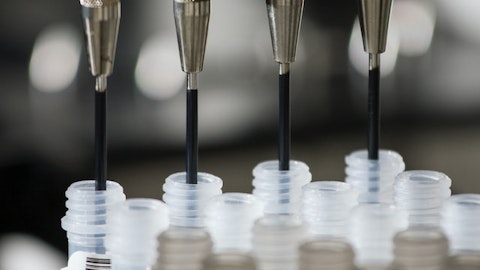Arcutis Biotherapeutics, Inc. (NASDAQ:ARQT) Q3 2023 Earnings Call Transcript November 3, 2023
Arcutis Biotherapeutics, Inc. beats earnings expectations. Reported EPS is $-0.73, expectations were $-0.9.
Operator: Good day, and welcome to the Arcutis Biotherapeutics Third Quarter 2023 Earnings Conference Call. [Operator Instructions] Please be advised that today’s conference is being recorded. I would now like to hand the conference over to your speaker today, Eric McIntyre, Head of Investor Relations. Please go ahead.
Eric McIntyre: Thank you, Abigail. Good morning, everyone, and thank you for joining this morning to discuss our Q3 2023 financial results. The slides for today are available on the Investors section of our website. On the call this morning, we have Frank Watanabe, President and CEO; Todd Edwards, our Chief Commercial Officer; Patrick Burnett, Chief Medical Officer; and John Smither, Chief Financial Officer. I’d remind everyone that we will be making forward-looking statements during this call. These statements are subject to certain risks and uncertainties, and our actual results may differ. With that, let me hand the call over to Frank. Frank?
Frank Watanabe: Thanks, Eric. So, I’m on Slide 5 of the deck now. So, we’re really pleased with the Arcutis team and our execution in the quarter. We made remarkable progress since the last time we spoke regarding our Q2 earnings. Starting off with the ZORYVE launch in psoriasis, that continues to gain momentum, and we now have over 110,000 prescriptions and about 9,000 unique prescribers launched to date, as our product delivers positive clinical experience for healthcare providers and their patients. This positive tailwind sets us up to launch our future topical roflumilast formulations as well from a position of strength. We also saw significant gross net improvements in the quarter, averaging in the low 70%s for the quarter.
Once again, we had flawless execution against our clinical and regulatory milestones with a steady flow of successes this past quarter. Patrick will go in a lot more detail in his remarks, but during the quarter, we received FDA approval for an expanded psoriasis indication down to the age of six. We filed a supplemental NDA for atopic dermatitis down to the age of six, with an expected approval in early Q3 of 2024. We announced positive pivotal Phase III data for AD in the 2- to 5-year-old range, and we released some really exciting long-term data in AD that demonstrated efficacy continues with — and actually improved with treatment with ZORYVE long-term up to 52 weeks, along with a very favorable long-term safety and dependable disease control.
We also strengthened our capital position with a follow-on raise we completed in October, as well as the upfront from the out-licensing deal we executed in Huadong for Greater China and Southeast Asia, and John will go into more details in just a minute. John will also talk about some more positive news around positive revisions in our SLR debt agreement that we’ve recently concluded. And we expect to — we continue to expand our intellectual property estate with the receipt of a new formulation patent in October, which is already listed in the Orange Book, very importantly. And we have a number of additional pending applications that we expect that we’ll issue soon, and which we’ll further build on the breadth and depth of our patent protection.
Moving on to Slide 6. We’re also very excited about 2024, as we are on the cusp of a very significant expansion of the opportunity for topical roflumilast in the coming year, which will translate into a substantial acceleration in our revenue trajectory. In the next 12 months, roughly, we will expand the total addressable market for ZORYVE, potentially about ten-fold, expanding our patient opportunity in the U.S. from roughly 1.3 million commercial psoriasis patients today to over 13 million patients as we add about 1.2 million patients — commercial patients with seborrheic dermatitis and about 1.4 million commercial patients with atopic dermatitis treated by dermatologist, following the anticipated approval for those indications. We could also add another 3 million patients across these same indications who have Medicare or Medicaid coverage and who are also treated by a dermatologist.
And then finally, we are actively working towards a strategic partnership that could allow us to expand into the roughly 6 million patients treated by primary care or pediatrics across those indications. We know there have been some questions about the pace of conversion from topical steroids to the newer non-steroidals. We talked about this back in Q1 about other similar markets with established generic standards of care and how those conversions to newer class of drugs occurred over time. And the topical dermatology market is right on track with these earlier prior examples with roughly 5% conversion one-year-end. We remain optimistic that the topical market will continue to convert and will eventually reach roughly 50% conversion. I’m also delighted to have Todd Edwards on board as our new Chief Commercial Officer, and his leadership and proven credentials in the topical dermatology market will only further enhance our commercial execution.
Under Todd’s leadership, we have a robust plan to further accelerate ZORYVE growth and our investing in our commercial operations to drive that growth. With that, let me turn it over to Todd to provide some further commentary around the ZORYVE psoriasis launch.
Todd Edwards: Thanks, Frank. I’m very enthusiastic about joining Arcutis team, and looking forward to the tremendous opportunity ahead. It is great to be speaking with all of you today to provide a brief commercial update. Moving to Slide 8. The ZORYVE psoriasis launch continues to progress nicely, and we have specific plans to further accelerate the launch trajectory, laying a solid foundation for sustained growth in psoriasis and further growth in new indications. As I come on board, I see healthy, steady ZORYVE demand that was driven by the strength of the clinical profile. After spending the last several weeks in meetings with dermatologists, MVs and PAs currently using ZORYVE, the feedback I received about the product is exceptional.
These prescribers spoke to me about the patients being delighted by the results achieved with ZORYVE. The NRx and TRx prescription volume is growing every quarter, and ZORYVE has over 100,000 Rxs launched to date. We are starting to see a preference for ZORYVE relative to non-steroidal competitor, and 8 in 10 ZORYVE writers are increasing their utilization of ZORYVE. The new pediatric label expansion down to six years of age incrementally expands our opportunities for growth, and further strengthens ZORYVE’s safety and tolerability profile. We expect demand growth as we capitalize on our investments in the launch and strengthen our field execution. One very large incremental opportunity to accelerate prescription growth is expansion into Medicaid and Medicare beginning in early 2024.
Roughly a third of psoriasis patients and nearly half of Seb Derm atopic dermatitis patients are on Medicare or Medicaid. ZORYVE’s pricing falls below the CMS specialty threshold, unlike other branded topicals, so we are much better positioned to access these patient segments. I am now on Slide 9. ZORYVE’s differentiated pricing and access strategy continues to resonate with payers with over 130 million commercial lives covered, 90% without a prior authorization. It was great to see that Arcutis team had secured coverage with all three large PBMs in the U.S. within 12 months of the launch. And most recently, Express Scripts modified the criteria for ZORYVE coverage, removing the double-step edit for patients who have intertriginous plaques in recognition of ZORYVE’s unique indication for treating these patients.
We anticipate further improvements in ZORYVE commercial coverage as we go into 2024 as well as accelerated commercial coverage for the foam at launch, with two of the top three PBMs expected to cover the product at approval as a line extension. We will continue to build upon the improvements seen in gross to net for Q3 and Q4, and expect that progress to continue in subsequent quarters, with us approaching our target gross to net for the psoriasis indication by the second half of 2024. From my experience, I am confident in the opportunity to improve gross to net with derm products. We are already seeing very encouraging trends at percentage of prescriptions being covered by insurers. With a clear opportunity to expand on this by enhancing our collaboration with contracted pharmacy partners to ensure willingness to improve coverage rates.
I’m now on Slide 10. The team has been focused on three pillars of commercial success for sustaining ZORYVE growth. Firstly, driving healthcare provider awareness and use. The prescriber base is growing steadily, with now about 9,000 unique prescribers since launch. And we just completed a 15% increase in field force size, focused on high-volume geographies. The field team will drive a broad efficacy messaging to move physicians along the adoption curve from initial trial in specific regions of the body, to expanded use for patients who have psoriasis plaques across their larger body surface area. Secondly, patient engagement as refills continue to be an important driver of long-term growth. The number of refills in the third quarter increased by 50% versus the second quarter, which continues to be encouraging and in-line with what we want and expect to see given the positive experience patients have with ZORYVE.
As mentioned, we also went live in September with a targeted DTC campaign to drive further branded requests. And finally, the broad high-quality access in both commercial and incremental Medicare and Medicaid coverage creates the opportunity for more patients to experience ZORYVE. We are also looking forward to upcoming launches and new indications. And so, I’ll hand it over to Patrick to cover that.

Patrick Burnett: Thank you, Todd. I’m now on Slide 12. As Frank highlighted, it’s been a very busy quarter, and I’m extremely proud of the team’s performance in delivering on the promise of topical roflumilast to the dermatology community and hitting all of our timelines with regard to regulatory milestones. So, starting with psoriasis first. Here, we announced the approval down to the age of six. This expands our current indication and the overall opportunity in pediatrics, and we look forward to adding to the five-year-olds in psoriasis, which will be the subject of a future FDA review pending some additional data. Moving on to Seb Derm, which will be the first indication for the foam where we have an upcoming PDUFA on December 16, with an early 2024 launch being planned.
Physician excitement for Seb Derm is palpable, driven both by our unprecedented efficacy with this once-a-day foam, and an area where there has been no innovation in decades and no branded competition, all this in a market as big as psoriasis. So, moving on to Slide 13, where I want to highlight a few points on the efficacy in Seb Derm. On the left, I’m showing the 80% of patients got the IGA success. This means that they reached clear or almost clear on the IGA scale in eight weeks, and they started from a baseline of moderate or severe. But what’s really generated a lot of excitement is on the right, where we show that we’ve got 50% of patients to completely clear. This means they had no erythema, no scaling, no evidence of disease. Not shown on this slide, but also we saw improvement in itch in as little as 48 hours after initiating treatment.
Itch is the primary symptom of Seb Derm, and really drives an impact on quality of life. So, moving on to Slide 14 now. Here, patient surveys highlight the significant negative impact that Seb Derm has on everyday life. Anxiety and a very negative impact on both social and work life with over three in four patients expressing anxiety about their disease. Over 90% say it negatively impacts their social lives. In addition, HCPs have expressed to me that they feel like they’re failing their patients in many instances, because patients keep returning and docs don’t have anything to offer beyond the same topical steroids and antifungals that they’ve been treating them with previously. We also recently reported quality of life data at the AMCP Conference, which showed the meaningful benefit roflumilast foam had in improving patient quality of life as measured by the Dermatology Life Quality Index, or DLQI.
Moving on to Slide 15. I see Seb Derm is having some dynamics that are favorable for rapid adoption. We have significant pent-up demand for this novel non-steroidal foam offering, primarily due to lack of brand competition and lack of innovation, but also higher patient dissatisfaction than what we see in psoriasis and a greater need for better treatment options, as many patients are on impractical treatment regimens composed of topical corticosteroids and antifungals that have significant limitations of use. We also have an opportunity to leverage the positive experience in psoriasis with those already prescribing and to leverage foam to further expand the ZORYVE prescriber base. As Todd mentioned, the benefits of accelerated commercial coverage for the foam and approval will also help with HCP confidence in prescribing.
Finally, moving on to atopic dermatitis. We made our submission of a supplemental NDA down to the age of six, with an anticipated approval in early Q3 2024. And also released a positive P — INTEGUMENT Ps readout for patients ages two to five in September. On Slide 16, we’re highlighting our recent release of very exciting long-term data in atopic dermatitis. The demonstrated efficacy continues to improve with long-term use, meaning four weeks in the pivotal trial and then an additional 52 weeks for a total of 56 weeks. Here, we’re showing EASI-75, which is a very clinically relevant endpoint, where the proportion of respondents grows from about 43% at week four, which is the end of the pivotal, to roughly 66% of patients achieving a 75 improvement at the end of treatment, which is 56 weeks.
This is really exciting where patients see an increased benefit over time and disease under better control. But what makes these data even more impactful is that we achieved this disease control with a less frequent maintenance regimen, where patients were switched to twice weekly treatment if they were completely clear. Very happy with this response. It fits nicely with clinical practice, and it’s been very well received by dermatologists. I’m very excited about roflumilast cream clinical profile and the significant opportunity in this large growing market. The dynamics here are favorable also for rapid adoption, showing some of the same positive tailwinds at Seb Derm. In particular, in pediatric patients, there’s a propensity to adopt non-steroidals, which is higher than in psoriasis, and this is driven largely by the desire of patients to avoid topical steroids.
With that, I’ll hand it over to John.
John Smither: Thank you, Patrick. Good morning, everybody. I’m beginning on Slide 18. For the third quarter, we reported net product revenue of $8.1 million, reflecting a 70% growth quarter-over-quarter on top of the about 70% growth in Q2. This was largely driven by substantial gross to net percentage improvements down to the lower 70s, particularly with the CVS coverage win and the team’s execution to ensure prescriptions are covered by insurers. We also saw healthy demand growth in the quarter. Looking forward to Q4, we expect further ZORYVE demand growth and gross to net improvement versus Q3. On Slide 19, I’ll walk you through the rest of the P&L. We reported total revenues of $38 million for the quarter, which included in other revenues, the upfront payment we received from Huadong collaboration and license agreement.
R&D expenses of $26.2 million were down significantly from Q3 2022, due to the upfront milestone payment for the Ducentis acquisition, as well as continued decrease of development costs of topical roflumilast programs. We expect Q4 R&D to be on par with Q3, and expect fiscal-year 2024 R&D expense to decline versus fiscal-year 2023. SG&A is a result of higher commercialization expense year-over-year, which reflects our continued investment in the ZORYVE launch and upcoming launches in Seb Derm and atopic dermatitis. As Todd mentioned, additional sales force will drive modest incremental SG&A growth in Q4 versus Q3. Lastly, net loss per share of $0.73 improved by over $1.15 per share year-over-year. Moving on to Slide 20. On the balance sheet.
Cash and marketable securities of $228 million as of the end of the quarter, which obviously does not include the recent raise of $100 million that we completed in early October. That raise provides a path to expand our psoriasis launch, as well as capitalize on the significant expansion and market opportunity for topical roflumilast into Seb Derm and AD. We also recently undertook a reorganization to resize all non-commercial efforts to align with R&D prioritization. You can expect us to continue to refine and sharpen our efforts around cash burn as we make continued progress on expanding ZORYVE in all indications. The net proceeds of the capital raised recently in October plus our existing cash plus what we believe to be our forecasted revenue provides runway into 2025.
We also remain confident in progressing an out-license deal in Japan, potentially by the end of ’23 to bring in additional non-dilutive capital, which would further extend our runway. I also want to provide some important updates on our amended loan terms, which we recently agreed to with our lender SLR. As many of you are aware, on the existing $200 million we have on the balance sheet that we’ve drawn down, there were two, in particular, financial covenants in place, a market cap covenant and a revenue covenant. I’m glad to report that the market cap covenant has been removed and has been replaced with a capital covenant, wherein the company has to obtain $31 million by the end of Q1 2024, which could largely come from an upfront payment that I just mentioned around the Japanese out-license.
The revenue covenant has been modified, requiring us to achieve at least 75% of our agreed-upon product revenue forecast, which replaces the previous minimum net product revenue table. For year-end 2023, this has an effect of reducing the $30 million trailing revenue requirement to below $25 million. Finally, the final loan tranche of $25 million has been eliminated. We appreciate SLR’s continued partnership, and are delighted with these changes and feel they provide the company with significant operating flexibility going forward. With that, I will hand back to Frank, the speaker and for some closing comments, and then we will open for Q&A.
Frank Watanabe: Thanks, John. As John mentioned, we continue to evaluate all of our activities as we transition from a development stage to a commercial stage company in order to effectively manage our expenses. Back in Q1, we announced a de-prioritization of a number of our R&D programs. And then based on those changes and as our ongoing large Phase III trials are winding down, earlier this quarter, we completed a limited restructuring to better align our organization with our ongoing activities. Today, with the expected approval of roflumilast foam and the successful submission of the AD sNDA, we’re announcing some further changes in our leadership to further align our organization with our priorities. Patricia Turney will be stepping down as our Senior Vice President of Operations, and David Osborne will be retiring as our Chief Technical Officer.
Both Patricia and David will continue on as consultants to the company to facilitate this organizational transition and to lend their extensive expertise in the future. We will be merging our technical operations and product development organizations and Bethany Dudek has been promoted to the role of Chief Technical Officer, overseeing the range of these activities. We’re excited to have Bethany taking over our technical operations. She’s been with Arcutis for the past three years as the Head of Quality and has done an outstanding job. I would add, I’ve worked with Bethany off and on for the past 15 years. She’s an outstanding executive and I feel very confident about her. She brings to her new position, extensive experience across product development and quality and manufacturing built over a 28-year career at Arcutis, Kite, Novartis and Amgen.
So, with the ongoing ZORYVE launch and all of the additional opportunities ahead of us, I believe we are incredibly well positioned to execute on our mission of building the preeminent immunodermatology company and continuing to build shareholder value. And with that, we’ll open it up for Q&A.
See also 10 DNA Stocks Billionaires Are Loading Up On and 20 Largest Cement Producing Countries in the World.
Q&A Session
Follow Arcutis Biotherapeutics Inc. (NASDAQ:ARQT)
Follow Arcutis Biotherapeutics Inc. (NASDAQ:ARQT)
Operator: Thank you. At this time, we’ll conduct the question-and-answer session. [Operator Instructions] Our first question comes from Tyler Van Buren with TD Cowen. Your line is open.
Tyler Van Buren: Congratulations on all the progress during the quarter. I have a couple for you related to Seb Derm. So, for the potential topical roflumilast approval for Seb Derm, can you elaborate on where you are with the regulatory review and if you’ve started labeling discussions? And then the second question, just regarding the launch trajectory and the coverage relative to ZORYVE. I think you mentioned that two or three — two of the three major PBMs expect to approve it as a line extension. So does that happen immediately upon approval? Or what’s the timeframe on logistics? And then also, how long do you think it will take to get the third PBM online?
Frank Watanabe: Yes, Tyler, great to hear from you. With regard to Seb Derm, as a policy, we don’t comment on ongoing reviews with the FDA. So I don’t feel it would be appropriate for me to make any comments on the process. I will say that I think we feel very confident about the upcoming PDUFA date. And we think that the data speaks for itself. With regard to the coverage, I think I’d ask Todd to respond to that one, if you could both to clarify around the first two and then our timing on the third.
Todd Edwards: Yes, absolutely, Frank. Thank you. And good question relative to the contracts and Seb Derm. So two of the — as mentioned, with two of the large PBMs within our contracts today, the Seb Derm launch will be treated as a line extension. So what that translates to is that we’re starting this launch at a position of strength, meaning that at launch, those two PBMs will cover Seb Derm as a covered product, which will help us also with a good strong — good start to our gross to net. The third PBM, we are currently in negotiations with, and those negotiations are very positive right now. So we look to further those conversations with the ambition of having coverage at launch with that third PBM.
Eric McIntyre: Thanks. Abigail, we can go to the next question.
Operator: [Operator Instructions] Our next question comes from Seamus Fernandez with Guggenheim Securities. Your line is open.
Seamus Fernandez: So maybe just as a first discussion point. Would you guys mind sort of comparing and contrasting the launch of ZORYVE? And where you are in the launch relative to the impact of the sort of vitiligo launch for the brands that you used to work with? I think it’s sort of an important and interesting comparison relative to the coverage dynamics as well as the opportunity for warehousing and sort of accelerated growth. So, just trying to get a relative sense of where you feel awareness is as a comparison? What this could mean for the overall brand? Because unique indications really do seem to accelerate brands overall. And then just maybe if you can provide us a little bit of color on how you see the — this sort of extension of coverage impacting gross to net, should we be thinking about overall gross to net having a step down or even a slight movement down in the fourth quarter to kind of accommodate that case?
And then just a question for John. It does state in terms of the covenants, the 75% of — can you just clarify the 75% of revenue target? Is that just for this year? Or is it the sort of sequential targets that are laid out, so 75% of all of the targets that are laid out in that sort of revenue planning phase?
Frank Watanabe: Seamus, it’s always good to hear from you. So just so we’re clear, you were asking Todd about ZORYVE and sort of the dynamics between psoriasis and Seb Derm and how that compares to OPZELURA and the dynamics with atopic dermatitis and vitiligo?



